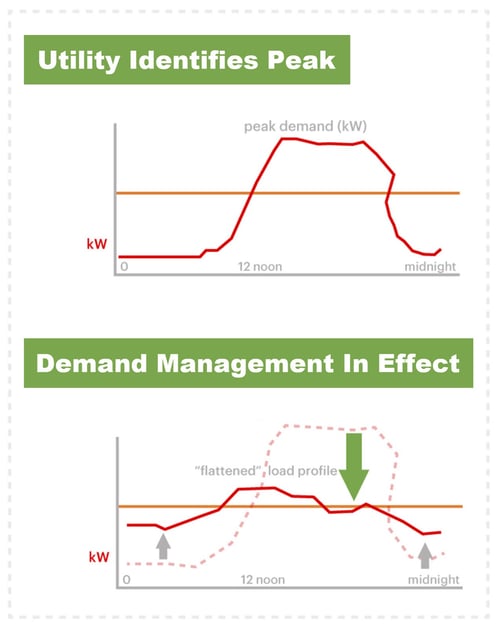Share this
What Retailers Should Know About Demand Management
by Phoenix Energy Technologies on Mar 30, 2020
 When retail stores and chains adopt a demand management program, they can take advantage of utility incentives and shift their demand curve to avoid peak rates. The problem is, it can be hard for retailers to do this, especially across a portfolio of locations.
When retail stores and chains adopt a demand management program, they can take advantage of utility incentives and shift their demand curve to avoid peak rates. The problem is, it can be hard for retailers to do this, especially across a portfolio of locations.
Demand management refers to programs that incentivize customers to reduce kW Demand for short periods. Utilities offer these programs in efforts to preserve grid integrity and flatten the demand curve to avoid brownouts and blackouts.
Utilities are getting down to managing the balance of grid supply and demand in ever shorter increments. Some demand management events last between 15-minutes to an hour, or as long as several hours. The notification period (when the utility lets you know you need to curtail electricity) also can be as short as minutes in the event of an emergency, or as long as a day or two. In rare cases, the exact date may even be forecasted ahead of time.
Of course, managing demand to avoid peaks is always desirable, to avoid hitting the peak rates, or changing your peak for the future. Peak load shifting or shaving are popular ways to avoid peak rates. Check out our article on Adaptive Energy Management to see one way of peak shifting.
What Kind of Demand Management Incentives are there?
Incentives vary a lot and can really add up.
Incentives can include:
-
- Lower net unit pricing in exchange for reduction during peak periods
- Tariff-based incentives with short-term increases in electricity cost
- Compensation to high volume users who abide by mandatory curtailment during heat waves
- Rebates for agreed-upon power reduction during high demands - sometimes this is referred to as negawatts.
- Negawatts are an asset that can be traded or sold back to electricity companies - although managing this requires a sophisticated energy management system to monitor the kWhs saved.
Smart grids will see more incentives evolve as the technology improves how utilities and energy users communicate, monitor, trade, and manage energy usage 24/7 and not just during demand management events.
Adaptive Energy Management - How to Use Your Buildings as a Battery
Barriers to Demand Management Adoption
So what holds retailers back from taking advantage of demand management programs? Often the sheer amount of building control strategies involved and the amount of program types keeps retailers shy of investigating and planning to make a move on programs.
Some companies feel they already have an efficient system and do not want to impact operations unnecessarily. One study shows that retailers can be uneasy that company goals could be hindered or that 24/7 operating businesses like hotels cannot reasonably shift power usage without impacting customer comfort.
Types of Demand Management Programs
There is a wide range of programs throughout the country. And as smarter technology and smart grids evolve, so too will the variety of options and opportunities. The primary commercial programs include Demand Response Programs, Peak Demand Programs, and proactive internal demand management.
Demand Response Programs
Demand response and Automated demand response programs see the customer limiting their kW consumed during times specified by a utility.
Types of programs include:
-
Emergency Demand Response
This is a program that offers incentives when a utility declares an emergency due to system capacity or reliability issues.
-
Economic Demand Response
This is a program that offers incentives during typical or identified peak demand times when electricity prices are high.
-
Ancillary Services Demand Response
This is a program that offers incentives that aid in supporting the transmission of electricity loads.
The above are some of the more common programs, but as mentioned, programs come in all shapes in sizes throughout the country.
Peak Demand Response Programs
Peak demand programs focus on offering credits for reductions.
Types of programs include:
-
Critical Peak Pricing (CPP)
CPPs offer credits during specific seasons/times of year when a utility declares a CPP event.
-
Real-Time Pricing (RTP)
RTPs target temperature-driven prices, with price reductions offered for customers who lower kW during these times.
-
Time of Use Base (load) Interruptible Program (TOU-BIP)
TOU-BIP are programs where credits can be accumulated for energy reductions with as little as 15-30 minutes notice from a utility.
-
Demand-Side Energy Management
This is a program that offers incentives through demand response auctioning, capacity bidding (CBPs), and energy storage initiatives.
Internal Demand Management
Increasingly we are seeing top-performing companies taking advantage of incentives from multiple programs and even developing their own programs that they take to utilities to consider. While this is rare, and hard to find information about as these companies tend not to broadcast these strategies, it just goes to show there are many evolving, flexible demand management programs out there.
-
Microgrids
This is a program that offers incentives for those power customers that have renewable energy storage capabilities either on-site or through a third-party.
Management & Verification
Managing multiple control systems that monitor store locations can be an impossible task and certainly doesn't allow for proactive response and management. Additionally, utility companies often require precise Measurement and Verification (M&V) reporting when businesses opt into demand management programs.
Smart Building IoT Solutions
A centralized control system gives customers visibility into systems across locations and the tools to manage systems despite local users manually changing the controls. An Energy Management System (EMS) gives energy customers a way to keep up with the M&V requirements.
A robust EMS system can:
- Quickly dig into any location and identify conditions, issues, and statuses
- Enable multi-action strategies that automatically react to kW usage, weather, occupancy, and more
- Give charting and historical trend data, including multi-point trending
- Give visibility of datasets across any location on any building control system for comparing and analyzing
- Allow access on multiple points of building data such as zone and supply temperatures, sensor status and set points
- Highlight problematic readings to help quickly identify issues and increase efficiency at the location level
Customer Comfort
Customer comfort does not have to be sacrificed for retailers to take advantage of demand management programs. Unfortunately, a lot of energy and facility managers misunderstand this. With the right placement of sensors and the best software and management tools, it is possible to manage setpoints and store energy for use during off-peak times. We cover this in some detail in our post What Should Building Setpoints Be Set To?
PhoenixET helps retailers gain precise building management control over multiple locations. These controls drastically save money, cut down on power usage, improve occupant comfort, and allow for data analysis across thousands of data points to meet demand management objectives.
We have put together five case studies spanning a variety of industries that outline how PhoenixET helps customers meet and exceed energy saving targets. You can access the studies on the below link.
Additional Resources
4 Common Myths of Energy Conservation in Building Management
Adaptive Energy Management Guide
Share this
- Facilities Management (91)
- Energy Management (69)
- Company News (49)
- Smart Buildings (37)
- Retail (36)
- Building Management (24)
- Building Automation Systems (21)
- Sustainability (20)
- Energy Demand Management (19)
- EEI (15)
- Adaptive Energy Management (14)
- Grocery (14)
- demand response (14)
- Artificial Intelligence (12)
- Data Integration and Visibility (10)
- HVAC IQ (9)
- COVID-19 (8)
- Customer Spotlight (8)
- Carbon Management (7)
- Setpoints and Temperatures (7)
- Equipment Maintenance (6)
- Operational Efficiency (6)
- Refrigeration Optimization (6)
- Ask Ron (5)
- Asset Manager (5)
- Finance and Procurement (5)
- IoT and Digital Transformation (5)
- Awards (4)
- Comfort (4)
- Energy & Store Development (4)
- Safety and Compliance (4)
- Demand Charge Management (3)
- Energy Management System (3)
- Lifecycle Asset Management (3)
- Premium Services (3)
- Refrigeration IQ (3)
- Automated Demand Response (2)
- ConnexFM (2)
- Customer Service (2)
- HVAC Vendor Management (2)
- Load Shedding (2)
- Technician View (2)
- AIM Act (1)
- ALD (1)
- Analytics (1)
- Data (1)
- Data Integration and Visualization (1)
- EMS (1)
- Knowledge Center (1)
- OSHA (1)
- asset management (1)
- December 2025 (1)
- November 2025 (1)
- October 2025 (2)
- September 2025 (1)
- August 2025 (3)
- July 2025 (1)
- June 2025 (1)
- May 2025 (2)
- March 2025 (2)
- February 2025 (1)
- January 2025 (2)
- December 2024 (2)
- October 2024 (1)
- September 2024 (1)
- August 2024 (2)
- June 2024 (2)
- April 2024 (2)
- March 2024 (2)
- January 2024 (1)
- December 2023 (1)
- October 2023 (2)
- September 2023 (2)
- August 2023 (2)
- July 2023 (1)
- May 2023 (2)
- April 2023 (2)
- March 2023 (3)
- February 2023 (1)
- January 2023 (1)
- December 2022 (1)
- November 2022 (2)
- October 2022 (2)
- September 2022 (1)
- May 2022 (2)
- April 2022 (1)
- March 2022 (3)
- February 2022 (2)
- January 2022 (4)
- December 2021 (2)
- November 2021 (3)
- October 2021 (1)
- September 2021 (3)
- August 2021 (4)
- July 2021 (1)
- June 2021 (2)
- May 2021 (1)
- January 2021 (2)
- December 2020 (2)
- November 2020 (2)
- October 2020 (3)
- September 2020 (4)
- August 2020 (3)
- July 2020 (2)
- June 2020 (3)
- May 2020 (3)
- April 2020 (5)
- March 2020 (5)
- February 2020 (4)
- January 2020 (4)
- December 2019 (4)
- November 2019 (3)
- October 2019 (4)
- September 2019 (5)
- August 2019 (4)
- July 2019 (4)
- May 2019 (2)
- April 2019 (3)
- February 2019 (1)
- December 2018 (1)
- November 2018 (1)
- October 2018 (3)
- September 2018 (3)
- August 2018 (3)
- July 2018 (3)
- June 2018 (3)
- May 2018 (1)
- June 2015 (1)
- March 2013 (1)
- January 2013 (1)
- December 2011 (1)
- October 2011 (1)
- September 2011 (1)



